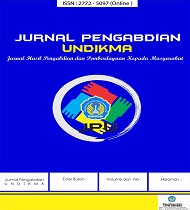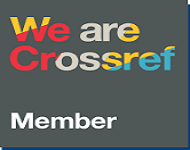Differences in the Effect of Offline, Blended, and Online Learning in Statistics Learning on Physical Education Students
DOI:
https://doi.org/10.33394/jk.v8i3.5705Keywords:
Online Learning Model, Offline Learning Model, Blended Learning Model, Statistics.Abstract
The purpose of this study was to analyze the difference in the effect of learning carried out face-to-face directly or offline, learning carried out offline, online and blended learning. The research method was a quantitative method with a design experiment. This research was conducted in Ambon city, Maluku-Indonesia. The population in this study amounted to 118 Physical Education Student Sampling was carried out randomly to obtain the number of samples using Slovin's formula: n=n/(1+ne2) = 74. Instrument used in this research is an essay test. The test scores from the two sessions were combined to get a total score of statistical learning outcome scores were analyzed using one-way ANOVA, but before being analyzed the scores were tested for requirements with homogeneity tests. Â The results of this study indicate that the learning carried out provides an overview of the different statistics learning outcomes based on the results of the F test with an F value of 7.131 and a p-value of 0.02. Based on the post-hoc follow-up test, it was found that the student taught by face-to-face or offline learning got better statistics learning outcomes than the students taught online, with a p-value of 0.02. Meanwhile, offline student statistics learning outcomes are not significantly better than student statistics learning outcomes taught using mixed methods or blended learning. Then, the statistics learning outcomes of students taught by mixed learning are not significantly better than online statistics learning outcomes. Thus, it can be said that learning that is carried out offline or face-to-face directly (Blended Learning) is still better and superior to learning that is carried out in Blended Learning and which is carried out online.
References
Badriyah, I. R., Akhwani, A., Nafiah, N., & Djazilan, M. S. (2021). Analisis Model Pembelajaran Daring dan Luring pada Masa Pandemi Covid-19 di Sekolah Dasar [Analysis of Online and Offline Learning Models during the Covid-19 Pandemic in Elementary Schools]. Jurnal Basicedu, 5(5), 3651–3659.
Bates, T. (1981). Towards a better research framework for evaluating the effectiveness of educational media. British Journal of Educational Technology, 12(3), 215 - 233
Collis, B., & Davies, G. (1995). Innovative Adult Learning with Innovative Technologies. New York: Elsevier.
D. Sewart. (1981). Distance teaching: A contradiction in terms? Teach Distance 19, 8-18.
Dhull, I., & Sakshi. (2017). Online Learning. International Education & Research Journal (IERJ), 3(8), 32–34
Fitriyani, Y., Fauzi, I., & Sari, M. Z. (2020). Motivasi Belajar Mahasiswa Pada Pembelajaran Daring Selama Pandemik Covid-19 [Student Learning Motivation in Online Learning During the Covid-19 Pandemic]. Profesi Pendidikan Dasar, 7(1), 121–132. https://doi.org/10.23917/ppd.v7i1.10973
Harasim, L. “Online Education: A New Domain (1989). In R. Mason and A. R. Kaye (eds.), Mindweave: Communication, Computers and Distance Education. Oxford: Pergamon Press.
Hillman, D. C., Willis, D. J., & Gunawardena, C. N. (1994). Learner-Interface Interaction in Distance Education: An Extension of Contemporary Models and Strategies for Practitioners. The American Journal of Distance Education, 8(2), 30–42
Institute for Higher Education Policy, What’s the difference? A review of contemporary research on the effectiveness of distance learning in higher education.https://files.eric.ed.gov/fulltext/ED429524.pdf (Diakses tanggal 3 Maret 2022)
Mahaly, S. (2021). Edudikara : Jurnal Pendidikan dan Pembelajaran Persepsi Mahasiswa terhadap Pelaksanaan Pembelajaran Daring Selama Masa Pandemi [Edudikara: Journal of Education and Learning Student Perceptions of the Implementation of Online Learning During the Pandemic]. 6, 109–116.
Marito, W., & Riani, N. (2022). Efektifitas Model Pembelajaran Blended Learning dalam Meningkatkan Kemampuan Berpikir Kritis dan Kemandirian Belajar Mahasiswa UPMI pada Mata Kuliah Statistik [The Effectiveness of Blended Learning Model in Improving Critical Thinking Ability and Independent Learning of UPMI Students in Statistics Course]. Jurnal Cendekia : Jurnal Pendidikan Matematika, 6(1), 223–233. https://doi.org/10.31004/cendekia.v6i1.1073
McIsaac, M. S., and Gunawardena, C. N. “Distance Education.†In D. H. Jonassen (ed.), Handbook of Research for Educational Communications and Technology (Association for Educational Communications and Technology). New York: Simon & Schuster, 1996
Moore, M. G. “Three Types of Interaction.†The American Journal of Distance Education, 1989, 3(2), 1–6.
Ningsih, S. (2020). Persepsi Mahasiswa Terhadap Pembelajaran Daring Pada Masa Pandemi Covid-19 [Student Perceptions of Online Learning During the Covid-19 Pandemic]. JINOTEP (Jurnal Inovasi Dan Teknologi Pembelajaran): Kajian Dan Riset Dalam Teknologi Pembelajaran, 7(2), 124–132. https://doi.org/10.17977/um031v7i22020p124
Ramage, Thomas R., "The "No Significant Difference" Phenomenon: A Literature Review" (2002). Dr. Thomas R. Ramage Scholarship. Paper 1. http://spark.parkland.edu/ramage_pubs/1
Syauqi, Khusni, Sudji Munadi, Mochamad Bruri Triyono. Students’ perceptions toward vocational education on online learning during the COVID-19 pandemic. International Journal of Evaluation and Research in Education (IJERE), 9(4), 881-886.
Urdan, T., & Weggen, C. (2000). Corporate E-Learning: Exploring a New Frontier. W. R. Hambrecht.
Downloads
Additional Files
Published
How to Cite
Issue
Section
Citation Check
License
License and Publishing Agreement
In submitting the manuscript to the journal, the authors certify that:
- They are authorized by their co-authors to enter into these arrangements.
- The work described has not been formally published before, except in the form of an abstract or as part of a published lecture, review, thesis, or overlay journal.
- That it is not under consideration for publication elsewhere,
- That its publication has been approved by all the author(s) and by the responsible authorities tacitly or explicitly of the institutes where the work has been carried out.
- They secure the right to reproduce any material that has already been published or copyrighted elsewhere.
- They agree to the following license and publishing agreement.
Copyright
Authors who publish with JK agree to the following terms:
- Authors retain copyright and grant the journal right of first publication with the work simultaneously licensed under a Creative Commons Attribution License (CC BY-SA 4.0) that allows others to share the work with an acknowledgment of the work's authorship and initial publication in this journal.
- Authors are able to enter into separate, additional contractual arrangements for the non-exclusive distribution of the journal's published version of the work (e.g., post it to an institutional repository or publish it in a book), with an acknowledgment of its initial publication in this journal.
- Authors are permitted and encouraged to post their work online (e.g., in institutional repositories or on their website) prior to and during the submission process, as it can lead to productive exchanges, as well as earlier and greater citation of published work.
Licensing for Data Publication
-
Open Data Commons Attribution License, http://www.opendatacommons.org/licenses/by/1.0/ (default)

This work is licensed under a Creative Commons Attribution-ShareAlike 4.0 International License.







